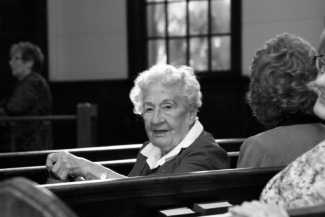January 29, 2016
Spiritual Well-Being for Older Adults
 When answering the question, “Who is your target audience?” most church leaders will say young people, or Millennials, or young families, or the unchurched. Very few will say their churches are focusing on people over 75. Yet look at the people sitting in the pews, or serving on altar guilds, or ushering, or pledging, or manning the food programs. Many are nearing 75 or are already in that age group.
When answering the question, “Who is your target audience?” most church leaders will say young people, or Millennials, or young families, or the unchurched. Very few will say their churches are focusing on people over 75. Yet look at the people sitting in the pews, or serving on altar guilds, or ushering, or pledging, or manning the food programs. Many are nearing 75 or are already in that age group.
Can a church be vibrant if it offers well-rounded activities for all ages, but targets older people? A church in Pennsylvania is exploring that question:
- At a recent retreat, the lay governing body at St. Paul’s Episcopal Church in Montrose, Penn., decided to focus the church’s ministry on older people at the church, in the community, in two senior living apartment complexes, and in one nursing home.
- St. Paul’s, which was founded in 1831 and is housed in a historic worship space, made a gallant effort in 2008 to create a ministry for young people that included additional personnel, new furniture and redecorated space, curricula, and supplies. After four years, the vestry concluded that other churches in the area were better equipped to serve young families.
- St. Paul’s has decided to approach their new ministry to older people carefully, beginning by asking church members and people in the community what they want or need. They intend to begin slowly, and build a ministry that can be sustained.
- Father Paul Tower came to the Center for the Ministry of Teaching with a basic question, “What will ministry to older people look like?” He has gathered resources about programming and guidelines for adult ministry, but there are no blueprints for the ministry that his church hopes to create.
- Changes in the worship space have already been made or are being made: a new surround sound system designed for people with hearing impairments is now in place, and new cameras are being installed to broadcast the primary Sunday worship service in high definition. Older people in the community will be able to worship weekly through a cable television broadcast of the primary Sunday service at St. Paul’s.
- There are many questions the church needs to answer. Will St. Paul’s no longer have intergenerational worship and community events? How will it welcome families and younger individuals that are attracted by their ministry?
- The demographics of the area, which is a magnet for retirees, indicate that there is a strong base for both a vital church and ministry to older people. Maybe more churches should ask the question, “Who is our target audience?”
- Most churches are not ready to abandon their courses of action to focus entirely on aging, but there are practices and approaches that could lead to richer, fuller ministry with older people in our churches and communities. In this and other posts we will look at how churches can respond with meaningful ministries to keep older adults a vital part of congregations.
Spiritual Well-Being
Churches have a different role in the lives of older people than social service agencies. Governmental agencies on aging in many areas throughout the country provide a range of social, medical, psychological, and emotional services for both older adults and caregivers.
Churches can promote those services as resources for the community, without duplicating programs and presentations about topics such as writing wills, setting up medical directives, among others. (If these services are not available, however, the religious community can work together to fill this need.)
The key component churches can provide to older populations is in the realm of the spiritual. While the spiritual well-being of people of all ages is obviously a goal of religious organizations, this post focuses on practices that are targeted to older adults.
In 1971 researchers, service providers, and religious leaders were invited to a White House Conference on Aging to discuss a number of issues, including spiritual well-being. That ignited the religious community in the United States to form the National Interfaith Coalition on Aging, which had representatives from the major Protestant, Roman Catholic and Jewish religious bodies. This definition came out of that group’s deliberations in 1977:
“Spiritual well-being is the affirmation of life in a relationship with God, self, community, and the environment that nurtures and celebrates wholeness.”
Donald F. Clingan, the first president of the coalition, has been working with that definition for over 25 years and concludes that it speaks clearly, especially to older adults. The spiritual, Clingan says, is not one dimension in life, but it permeates and gives meaning to all life. It goes beyond physical, psychological, or social good health to embrace an affirmation of life.
“It is to say ‘yes’ to life,” he says, “in spite of negative circumstances.” An affirmation of life, which is rooted in a community of faith, acknowledges the destiny of life to love oneself and others.
Seeing God as supreme being and creator of life enables us to grow in wholeness as individuals, responding to God in love and obedience. Because human wholeness is not attainable in a lifetime, life gains significance through a person’s relationship with God. We learn to live into the possibility of becoming whole.
The coalition’s definition around spiritual well-being, Clingan says, “has an eternal quality. . . . it does lift up the centrality of a relationship to God, the Supreme Being, the Creator of life, which is universal to all faiths, and certainly is an imperative to spiritual well-being in all our lives.”
Ministry for Wholeness
As the coalition’s definition makes clear, we cannot separate our spiritual lives from the wholeness of life. At the same time, it is helpful to distinguish among ministry for the body, mind and soul, with the intent of weaving those disparate parts into a whole cloth.
The next Key Resources post will examine practices and approaches to ministry in each of three areas—physical, mental, and spiritual—with the understanding that each is only a part of the whole person.
While the practice of ministry to the whole person touches all three areas, the mix of activities should reflect the needs and contexts of each congregation. All ministries for older adults should also reflect their development, generational, and spiritual characteristics.
Programming should never be planned without the active input of the targeted audience. Activities should be created for “us” and by “us;” those created solely by staff or well-meaning people for “them” are doomed to fail.
Quotes by Donald Clingan cited above came from: Thorson, J.A., ed. Perspectives on Spiritual Well-Being and Aging, Springfield: Charles C. Thomas, 2000, xi-xiv.
The post Spiritual Well-Being for Older Adults appeared first on Key Resources and is reposted with permission. It is also part of a series inspired by the Seasons of Adult Faith Formation book, symposium, and special issue of Lifelong Faith Journal.
Don't miss a blog post! Subscribe via email or RSS, using the grey box on the upper right.





